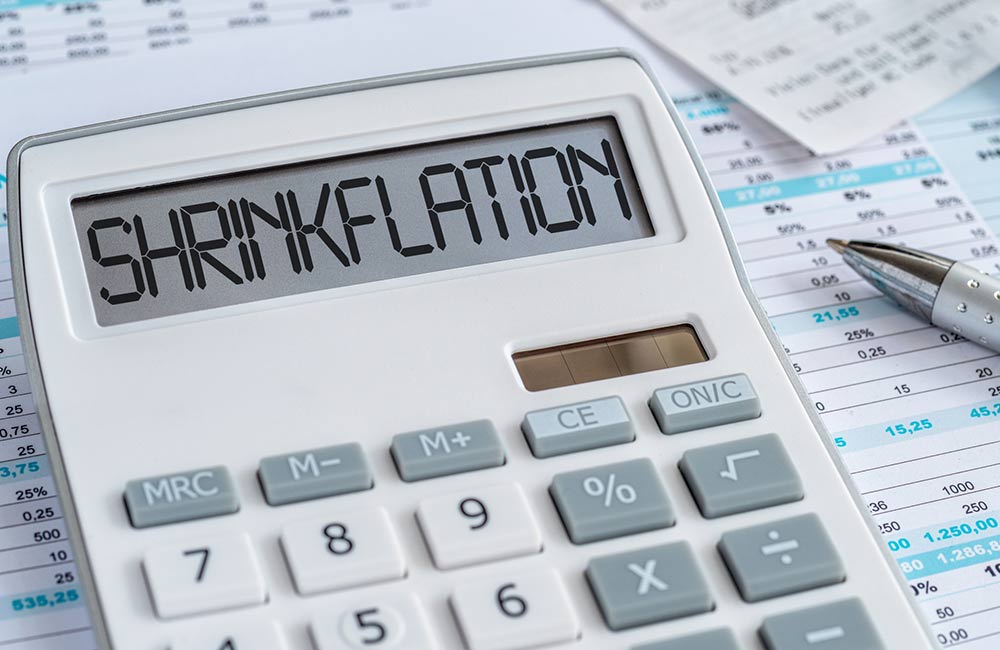Although people with dementia may have problems understanding what you’re...
Is ‘shrinkflation’ (and ‘skimpflation’) affecting your bottom line? And how to minimise the risks.
This week I’ve had 2 experiences of ‘shrinkflation’
Firstly, I received a call from Anna, a longstanding and loyal customer, who wanted my help.
Anna was aware that the hospital where she works had become victim to ‘shrinkflation’ and ‘skimpflation’ on some of their hygiene consumables, her weekly bills were rising as a result, and she was exceeding her budget.
Anna wanted my advice on how best to avoid the pitfalls of ‘shrinkflation’
Secondly, I was trying to buy washing tablets in the ‘lowest cost supermarket for 3 years running’
I always pay attention to the unit quantity price information contained on the label on the shelf, however for some of these laundry products there was no price label, and I will never actively choose a product when I don’t know how much it’s going to cost me.
So I picked a well known ‘trusted household brand name, because it was advertising a low price, however when I opened the tub, I discovered it to be only HALF FILLED.
I had also been cheated by shrinkflation ☹
So what are ‘shrinkflation and ‘skimpflation?’
‘Shrinkflation’ occurs when businesses reduce the size or quantity of products without lowering the price. It's a subtle way to pass on increased production costs to consumers while maintaining the appearance of price stability.
The reduction in pack size is sufficiently small as not to be immediately obvious to regular customers.
An unchanged price means that customers are not alerted to the higher unit price, however this practice adversely affects customers' ability to make informed buying choices.
‘Skimpflation’ involves maintaining product prices while sacrificing quality or features. It's a cost-saving measure that can erode the perceived value of products or services.
These practices by manufacturers and suppliers have been described as ‘deceptive and immoral’, and ‘a dark art that steals away the buying power of consumers who don't understand it’.
And consumer advocates are critical because they have the effect of reducing product value by "stealth".
Anna, my customer (not her real name) who’s responsible for stock checking and ordering supplies for the hospital, has noticed that where she used to order 6 cases of toilet rolls regularly every week, she now needs to order 7-8 cases to do the same job, due to shrinkflation, thus increasing her weekly bill.
And her black refuse sacks which used to measure 18x29x39cms have reduced both in size and density , due to skimpflation, resulting in her having to ‘double bag’ to prevent the sacks from splitting, and her using twice as many, ……… completely false economy.
So how can you navigate shrinkflation?
Conduct Comprehensive Supplier Analysis
- Engage with Your Suppliers: Engage in collaborative discussions with your suppliers to explore cost-saving opportunities, negotiate favourable terms, and address concerns proactively.
- Evaluate Supplier Relationships: Assess existing supplier relationships to determine their reliability, flexibility, consistency and responsiveness to market changes.
- Seek Transparency: Demand transparency from your suppliers regarding any changes in product sizes, quantities, or quality to allow you to make informed purchasing decisions.
Focus on Total Cost of Ownership
- Look Beyond the Initial Price: Consider the total cost of ownership, including factors like potential reordering frequency, to assess the true value of products or services.
Monitor Market Trends and Consumer Behaviour
- Stay Informed: Keep abreast of market trends, inflation rates, and consumer behaviour to anticipate potential price changes or shifts in demand.
- Adapt Quickly: Remain agile and adaptable in response to market fluctuations, adjusting buying strategies accordingly to maintain competitiveness.
Look for industry accreditation schemes which GUARANTEE you value

The Cleaning and Hygiene Suppliers Association operates a number of accreditation schemes which covers the manufacture of soft tissue, plastic sacks and cotton mops.
The schemes guarantee that all products are fully labelled with lengths, widths and sheet counts etc, and a guarantee that the product in the box meets the specification on the label.
The dimensions of the soft tissue paper products are as specified and the industrial cotton mops and refuse sacks are fit for purpose and dimensions are specified.
This ensures you can be confident “what is on the box is in the box” and the product is traceable to the manufacturer and specific batch.
Product labels that state an ‘approximate’ length, width, count or weight cannot be trusted 100%
If a label says there are approximately 200 sheets on a paper roll there could easily be just 180 sheets. If there are approximately 100 sacks in a pack, there may only 90. There is no way for you to know, unless you physically check.
You wouldn’t accept an approximate amount of money dispensed by a cash machine!
Approximate is not good enough. By definition it’s not precise. You have no guarantee you are getting what you pay for. The only way you can be certain, is to buy products stamped with the Marque of a relevant Accreditation Scheme
The only way you can be certain the product you receive is not ‘short’ in number or size, common problems with non-Accredited products, is to buy industry accredited products that guarantees what’s on the box is what’s in the box.
Here at @hcsuk we’re extremely proud to stock paper products, refuse sacks and cotton mops which have been independently tested and CHSA accredited.
Please visit www.chsa.co.uk if you are interested in learning more about the CHSA accreditation scheme and what it means for you, the customer.





-1.jpg?width=352&name=Meet-the-team_Phil-Cotton-2%20(1)-1.jpg)